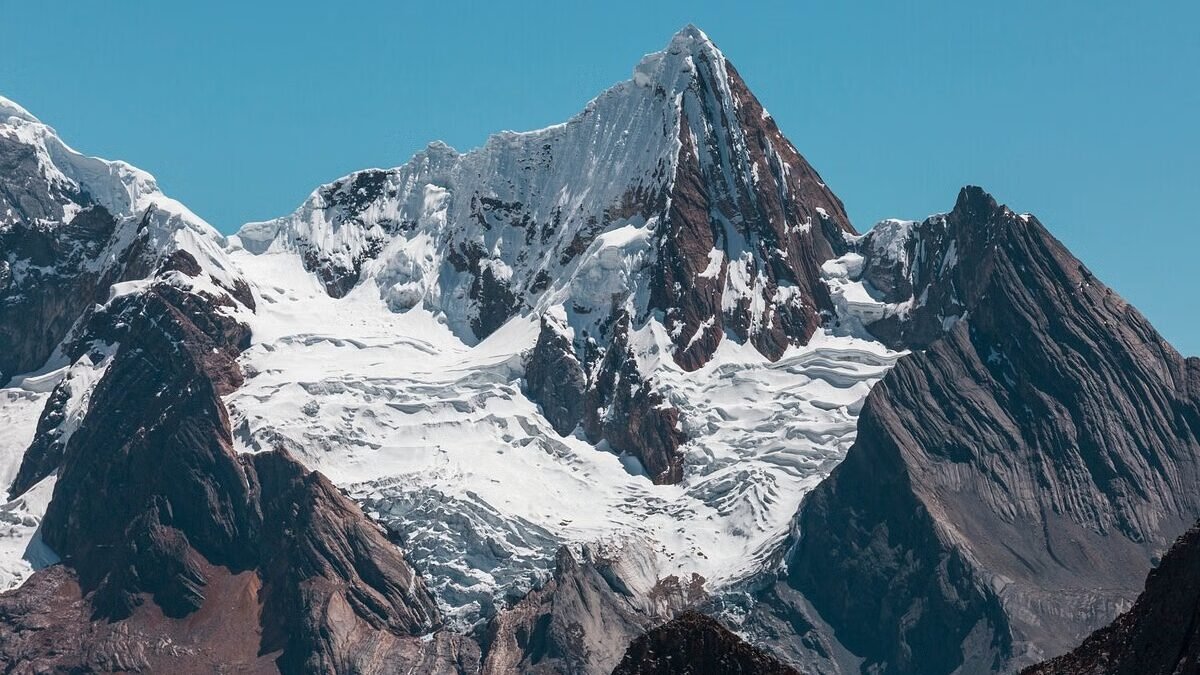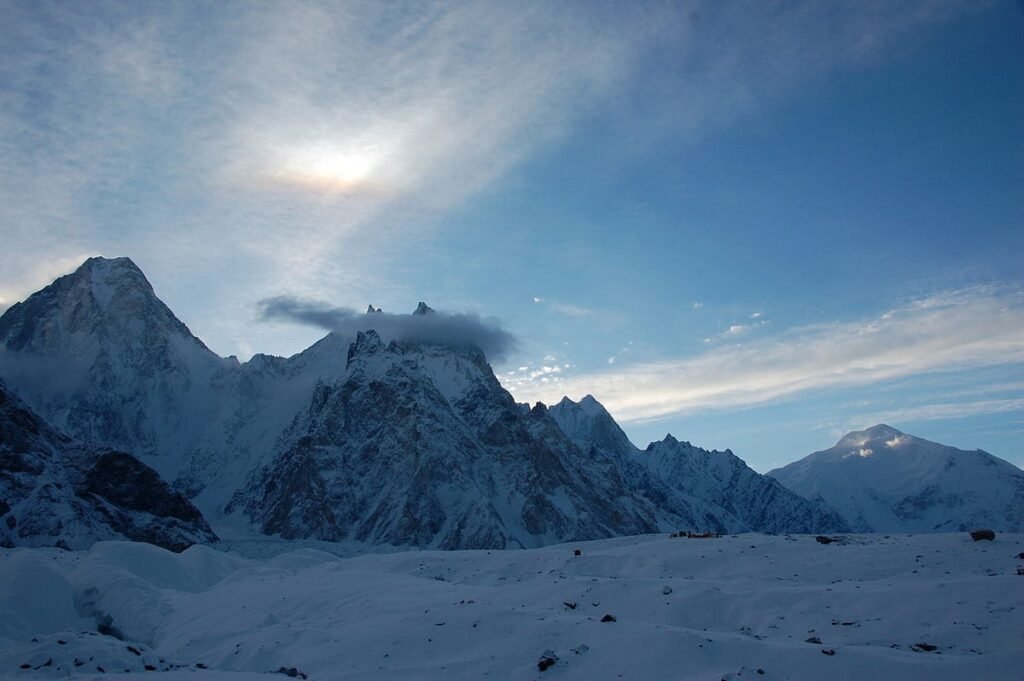Saltoro Kangri, a remote gem of the Karakoram, stands not only as one of Earth’s highest and most formidable peaks but also as a crossroads of history, challenge, and culture.
Saltoro Kangri, standing at an imposing 7,742 meters (25,400 feet), is the crowning peak of the Saltoro Mountains, a vital subrange of the legendary Karakoram. Revered as the 31st highest peak on the planet, this summit’s allure is woven through tales of exploration, geopolitical intrigue, military history, and the enduring spirit of both nature and humanity.
Location and Physical Characteristics
Saltoro Kangri rises on the western fringes of the Siachen Glacier, straddling the contentious Actual Ground Position Line (AGPL) between Indian-administered Ladakh and Pakistan-administered Gilgit-Baltistan. Its precise coordinates, 35.3993°N, 76.8486°E, place it within a spectacular world of jagged ridges, deep glacial valleys, and stark, forbidding beauty.
- Saltoro Kangri is composed mainly of ancient hard granite and metamorphic rocks, shaped over aeons by the clash of the Indian and Eurasian tectonic plates.
- The surrounding terrain is a splendour of icy slopes, towering ridges, and colossal glaciers, with the Siachen Glacier, the world’s highest, forming the area’s ecological and geographic heart.
Key Details:
Note:
- Visiting Saltoro Kangri is logistically challenging due to the presence of military activities and its location in a contested region.
- Permit requirements, access, and cost will vary each year and by the route/operator chosen.
For trekkers and climbers, the best approach is through experienced tour operators with a proven track record of success in Karakoram expeditions. Always confirm the latest travel advisories and permissions before attempting to visit or climb Saltoro Kangri.
Historical Significance and Cultural Footprint
The valleys and routes near Saltoro Kangri once served as arteries for the ancient Silk Road, bringing trade and spiritual exchange between Tibet, Ladakh, and Central Asia. Local communities in the Saltoro region possess distinct traditions, shaped by both isolation and international interest.
In the modern era of politics, Saltoro Kangri became inextricably linked to the Siachen Conflict, where control of the glaciers became a matter of national pride and global strategic interest. Operation Meghdoot (1984) and subsequent military deployments established the region as one of the world’s highest battlefronts, often referred to as the coldest war zone on Earth.
Despite this history, valleys remain culturally rich:
- Local Balti traditions persist, emphasising oral history, folklore, music, and artisan crafts handed down for generations.
- The valleys offer timeless festivals, unique music, and cuisine rooted in the resilience needed to thrive in such terrain.
Climbing and Mountaineering: Routes, Achievements, and Challenges
Saltoro Kangri is revered among mountaineers for both its technical challenge and restricted access. Its icy bastions have deterred all but the most determined:
- The peak features two main summits, Saltoro Kangri I and II, separated by a perilous saddle.
- The major climbing routes include the Southwest Face (noted for steep, technical ice), the North Ridge, and the formidable West Face.
- First ascent: July 24, 1962, by a joint Japanese-Pakistani team led by T. Shidei. Notable climbers included A. Saito, Y. Takamura, and R.A. Bashir.
- Few successful expeditions have followed due to harsh conditions and political sensitivities; the Indian Army notably led an expedition in 1981.
- All approaches, via Bilafond La, Kondus Valley, or Nubra Valley, require navigating treacherous ice fields, potential avalanches, and severe weather.
Tourism: Trekking, Expeditions, and Accessibility
The beauty and challenge of Saltoro Kangri have long attracted the respect of explorers, although the region’s contentious status and military overseers restrict large-scale tourism:
- Access from the Indian side is highly regulated and almost entirely reserved for military expeditions due to security concerns.
- Limited trekking and expeditions are permitted from the Pakistani side, with routes originating in Skardu and the Kondus Valley, contingent upon obtaining necessary security clearances.
- The region’s treks are characterised by dramatic glacial landscapes, remote valleys, and a sense of absolute solitude. Key sights include the Siachen Glacier, Bilafond La, Kondus Valley, and Saltoro Valley itself.
- Local guides offer insights into both geography and culture; however, proper preparation, acclimatisation, and advanced mountaineering skills are essential.
Climatic Influence and Ecological Characteristics
Saltoro Kangri, towering above the Karakoram, shapes regional climate and supports a limited but unique array of life forms:
- Winters bring fierce cold, with temperatures sinking far below freezing, frequent blizzards, and hurricane-force winds, sometimes making winter climbing life-threatening.
- Summer, while slightly more temperate, is brief; clear skies offer breathtaking views, but unpredictable storms and rapidly changing weather remain constant threats.
- The region’s ecological highlights include high-altitude eagles, Himalayan ibex, and the elusive snow leopard. Vegetation is stark: alpine moss, lichens, and hardy grasses in sheltered lower valleys.
- The Siachen Glacier, influenced by the surrounding mountains, is a crucial water source for northern India and Pakistan. Its rapid melting due to climate change is a pressing environmental concern for millions.
Geopolitical and Strategic Significance
Saltoro Kangri’s importance extends beyond natural wonder to the realm of strategic and geopolitical complexity:
- Situated on the critical AGPL, the mountain is central to India-Pakistan military standoffs, with both countries establishing high-altitude outposts to control the Saltoro Range.
- The 1984 Operation Meghdoot by the Indian Army solidified India’s presence; Pakistan maintains posts to the west, with the Siachen Glacier forming an icy buffer.
- Saltoro Kangri’s region is one of the world’s most inaccessible, patrolled by some of the bravest soldiers and mountaineers.

Recent Developments and Adventure News
The autumn 2025 Himalayan climbing season brought worldwide attention to this remote area. The first successful ascent of Chumik Kangri, a 6,754-meter peak in the Saltoro region, marked an expansion of expedition access and rekindled global mountaineering interest.
- Expeditions are now venturing deeper into the unexplored valleys of Saltoro, signalling renewed focus on both adventure and research.
- Global attention amplifies hopes for peaceful scientific cooperation and responsible eco-tourism in this sensitive borderland.
FAQs About Saltoro Kangri
Where is Saltoro Kangri located?
Saltoro Kangri is situated in the Saltoro Range of the Karakoram, near the Siachen Glacier, straddling India’s Ladakh and Pakistan’s Gilgit-Baltistan.
How high is Saltoro Kangri?
The mountain rises to 7,742 meters (25,400 feet), making it one of the tallest peaks in the world and the fourth-highest in India.
Is Saltoro Kangri accessible to tourists?
Access is highly restricted due to its proximity to conflict zones, but limited guided expeditions originate from Pakistan with security clearances.
What is the best season for trekking or climbing?
Summer (June to August) offers the most favourable conditions, but fierce weather and unpredictable storms are always possible.
What wildlife and vegetation are found near Saltoro Kangri?
Sparse alpine flora, snow leopards, Himalayan ibex, and high-altitude birds inhabit pockets of the lower valleys.
Why is Saltoro Kangri important geopolitically?
It is central to the India-Pakistan territorial dispute over Siachen, lending it immense military and strategic value.
Has Saltoro Kangri been summited?
Yes, first in 1962 by a joint Japanese-Pakistani team, followed by an Indian Army expedition in 1981. Few recorded attempts since.
What makes Saltoro Kangri unique among Himalayan peaks?
Its extreme remoteness, formidable conditions, and geopolitical relevance make it one of the least-explored 7,000m+ mountains on Earth.
